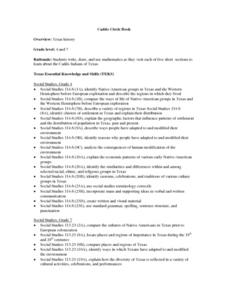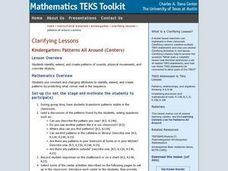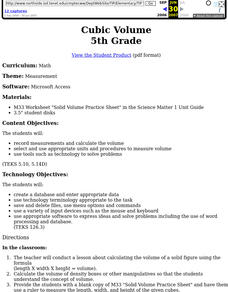Curated OER
Caddo Circle Book
Pupils are introduced to the Caddo Indians of Texas. Using a compass, they draw a circle given specific dimensions and cut them out. Using the text, they read one section abut the Indians and complete the task listed on one of their...
Curated OER
Mapping and Excavating a Jello Mold
Fifth graders, in groups, map the three layers of different colored jello layers in molds and note the placement of fruit in them. On the grid paper they draw each grape, raisin, or other object and carefully remove each layer. After...
Curated OER
Technology Integration Lesson Plan: Music Database
Eighth graders gather information on fifteen of their favorite songs, create database with fields representing different attributes, explore and sort their databases, and create charts and graphs showing amount of play time vs. popularity.
Curated OER
Family Purchases
Students generate a gift list for their family members making sure the costs remain under budget. They research the cost of items on the internet, calculate sales tax, and determine the total cost for all of the gifts.
Curated OER
How Do You Spend Your Time?
Students keep records and determine how much time they spend on certain activities. They insert the data into a spreadsheet. Students graphically display data in a bar graph and a circle graph.
Curated OER
Classic Storytelling with a Technology Twist
Students use technology to improve their knowledge of literary terms, math, and technology skills. In this technology storytelling lesson, students learn about character, plot, and setting in various stories by using technology like...
Curated OER
Hop to It
First graders play a game of hopscotch, but hop to the answer of the addition or subtraction fact the teacher calls out.
Curated OER
Rolling Records
Fourth graders play a game to determine the likelihoods of different outcomes when rolling two number cubes. Students play a game to determine the likelihoods of different outcomes when rolling two number cubes.
Curated OER
Belongs, Doesn't Belong
Fifth graders discover the rule used to sort a set of data into two sets, those data that belong according to the rule and those data that don't belong. Students participate in a game to determine the rule. They discuss strategies for...
Curated OER
Grade 3: Pretzel Probability
Third graders discuss prizes included in products to stimulate sales. They discuss a pretend pretzel company and it's sticker promotion. Students compute how many boxes of pretzels they will need to collect in order to be sure of having...
Curated OER
Tantalizing Tangrams
Fourth graders participate in what is considered to be a model lesson. The lesson focuses upon polygons and basic geometry. The lesson addresses national standards and displays how others should be done.
Curated OER
Patterns All Around (Centers)
Students identify, extend, and create patterns of sounds, physical movements, and concrete objects. They brainstorm patterns found in the classroom. Students use mathematical attributes to identify patterns and predict what comes next.
Curated OER
Grade 2: Texas Problem Solving
Second graders use numerical data about Texas to write and solve real-life problems involving addition and subtraction (or multiplication and division). They work in pairs to choose three numerical facts about Texas to use to make up...
Curated OER
Double Dipping
Fifth graders find and display all possible pairs of flavors of ice cream and look for patterns in the results. They discuss strategies for finding all combinations of flavors. Students explain and write a description for the pattern...
Curated OER
Hooked On Problem Solving
Fourth graders use properties of operations and problem-solving strategies to do mental calculations, and look for patterns in the solutions. They create an array, using each of the digits 1-9 exactly once to form addition problems...
Curated OER
And Around We Go!
Sixth graders conduct a survey and collect data to construct a bar graph that will then be changed into a circle graph. With the bar graph, 6th graders compare estimated fractions and percentages and estimate percentages. With the circle...
Curated OER
Pepe Cleaners
Seventh graders gather data to determine the relationships between the base and height of rectangles with fixed perimeters and express the relationships using words and symbols. Students build rectangles with pipe cleaners. They create...
Curated OER
Algebra I: A Draining Swimming Pool
Young scholars analyze and develop symbolic representations to describe the amount of water left in a pool being pumped out after a given amount of time, with various pumping rates and initial quantities of water in the pool.
Curated OER
Algebra II: Crickets-Nature's Thermometer
Students translate functional relationships into equations to answer questions. Students answer questions using different representations of the relationships: function rules, graphs of the function, tables of values, and equations and...
Curated OER
Mathematical Models with Applications: What's Your Rate of Change?
Students use regression methods available through technology to select the most appropriate model to describe collected data and use the model to interpret information. They use numeric techniques to write the equation of a line that...
Curated OER
The Sum of the Parts
Second graders observe some everyday common objects in order to attempt to learn about simple systems and how they fit together. They observe small details in order to identify the parts of a whole design.
Curated OER
Sun and Clouds
First graders use Kidspiration software to practice putting pictures on screen in a straight line. They examine pictures of suns and clouds and create as many different combinations of seven from pictures that they can.
Curated OER
Using Averages to Create Graphs Through Excel
Sixth graders create and use a spreadsheet to make graphs which will be used to analyze Progress Report and Final Report Card grades. They practice finding the mean, median, mode, and range of a data set. Students also incorporate column...
Curated OER
Cubic Volume
Fifth graders record measurements and calculate the volume. They select and use appropriate units and procedures to measure volume # use tools such as technology to solve problems























